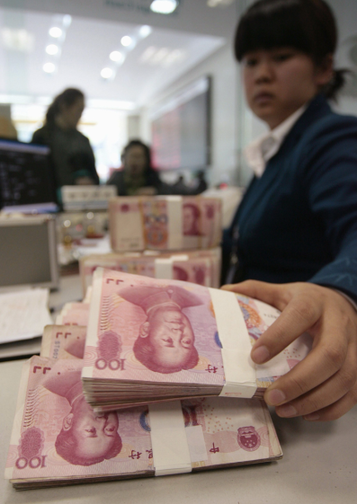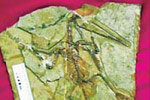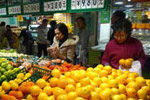Business
CBRC to focus on credit, liquidity
Updated: 2011-01-18 07:44
By Wang Xiaotian (China Daily)
|
 An employee counts yuan notes at a bank in Nanjing, Jiangsu province. Sean Yong / Reuters |
Banks' January blowout could push lending too high, analysts say
BEIJING - The China Banking Regulatory Commission (CBRC) said on Monday it will put curbing credit and liquidity risks at the top of its agenda of banking regulation in 2011 and promote reasonable lending to efficiently serve the economy.
"We will watch closely for systematic and regional risks, to make sure the banking industry runs stably and safely, and help to promote sound development of the real economy," said Liu Mingkang, chairman of the CBRC.
He said the commission will pay more attention to the pertinence and effectiveness of regulatory measures to better check the risks.
Liu made the remarks in an article published Monday evening after the CBRC started its annual work conference on the same day.
However, commercial banks have started their annual sprint to lend as much as possible in January while the central bank is gearing up to keep the lending pace steady and controllable.
In the first 10 days of January, four leading state-owned commercial banks - the Industrial and Commercial Bank, Agricultural Bank of China, Bank of China, and China Construction Bank - have lent nearly 240 billion yuan ($36.39 billion), according to the Beijing-based Century Weekly magazine.
That sum would indicate that lending will probably reach 1.5 trillion yuan in the first month of 2011, it cited a bank executive as saying.
A source told China Daily that the People's Bank of China, the nation's central bank, has asked the banks to limit their annual credit blowout in January to 1.2 trillion yuan and that the differentiated reserve-requirement ratio might be further raised to ensure that limit.
The source said the overall credit target in 2011 will be 7.5 trillion yuan. Unlike in previous years, the target includes lending outside the balance sheet of banks, and will be kept internally instead of being published.
In 2010, the banks lent as much as 1.39 trillion yuan in the first month, after loans hit a record high of 1.6 trillion one year earlier.
"This year's new yuan lending will certainly shrink compared with last year, as the government tries to tighten liquidity and curb inflation, but the loans won't drop as much as 10 percent," said Dong Xi'an, chief economist with Industrial Securities.
Local media have reported that the government won't publish a specific limit for the new yuan lending in 2011, as it often did in previous years. Instead, it will set an internal target of about 7 trillion yuan and try to be more pertinent and flexible in its regulatory measures, China Business Journal reported.
To strengthen control over banks' monthly credit, the country's central bank will check credit and capital levels of commercial banks monthly, and raise the reserve requirements of individual lenders if their capital-adequacy ratios cannot meet government targets, according to the China Securities Journal.
An increased rate of M2, the broad measure of money supply that includes cash and all types of deposits, might become the central bank's only published regulatory target. It rose by 19.7 percent over the previous year by the end of 2010, the central bank said on Jan 11. Dong said the target for this year will be around 16 percent.
China has been facing the problem of excessive liquidity since the government introduced stimulus measures worth $586 billion in late 2008 and adopted a monetary policy to propel an economy battered by the global financial crisis.
Increased capital inflows, as investors sought a safe haven in China, could also have contributed to the problem, said analysts.
In November, China's consumer inflation jumped to 5.1 percent, the fastest clip in more than two years, stoking fears of accelerated inflation as a result of excessive liquidity.
In 2010, new yuan loans reached 7.95 trillion yuan, exceeding the government's target of 7.5 trillion yuan.
The country's foreign exchange reserves rose to a record $2.85 trillion by the end of last year, an 18.7 percent increase year-on-year, sparking concerns about the country's already excessive liquidity
Wang Tao, head of China economic research at UBS Securities, expects a further net issuance of central bank bills and more hikes to banks' reserve requirement ratios in 2011.
The People's Bank of China announced on Jan 14 that it will raise the reserve-requirement ratio for lenders for the fourth time in two months by 50 basis points by January 20.
That means the proportion of money banks must keep as reserves for the country's biggest banks will be at a record 19.5 percent after the move.
But Li Yining, a professor at Peking University, said on Saturday at the Annual Meeting of China's Economy that the current inflation is propelled mainly by rising costs, and a shrinking macroeconomic stance won't solve the problem effectively.
"China should tighten fiscal policy and loosen its monetary stance instead of doing the reverse. Otherwise, the economy will risk stagnating in 2011, with higher inflation, higher unemployment, and lower economic growth," said He Keng, deputy head of Financial and Economic Affairs Committee under the National People's Congress.
He said the government should let the commercial banks determine how much money they will lend, instead of setting a specific credit limit for them.
China Daily
Specials

President Hu visits the US
President Hu Jintao is on a state visit to the US from Jan 18 to 21.

Ancient life
The discovery of the fossile of a female pterosaur nicknamed as Mrs T and her un-laid egg are shedding new light on ancient mysteries.

Economic Figures
China's GDP growth jumped 10.3 percent year-on-year in 2010, boosted by a faster-than-expected 9.8 percent expansion in the fourth quarter.